Brookfield Plantation
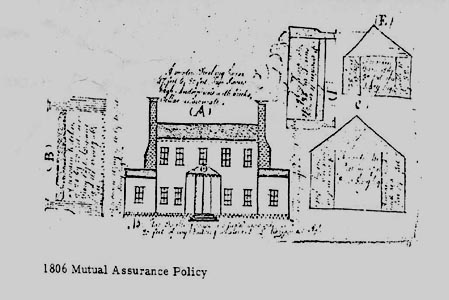
Brookfield was the 2,000 acre plantation of the Prosser family in the late 18th century. It was here, in the year 1800, that Thomas Prosser's most trusted slave , a 24-year old black preacher named Gabriel, masterminded a massive slave uprising. The plot failed because of two slave informers belonging to the Sheppard family of Meadow Farm and because of a torrential thunderstorm that severely impeded transportation and communications.Gabriel and most of his inner circle were captured, brought to trial and subsequently hanged.

The main dwelling at Brookfield is described in insurance policies of 1802, 1806, and 1815; it was a substantial two-storey frame, 5 bay structure with flanking one-storey wings. The farm passed from Thomas Prosser to Benjamin Sheppard between the rears 1806 and 1815. In the mid-19th century, the earlier house was evidently replaced by an even grander one. This mansion, which burned to the ground in 1910, was for many years the home of the prominent Dicken family. The later house at Brookfield was a two-storey frame structure whose most conspicuous feature was its colossal hexastyle pedimented portico with Corinthian columns. Two bronze lions now located in the yard of a home on Chamberlayne Avenue originally flanked the front steps to this house.
- (County of Henrico,1995 (HC3))
>Back to Top<
Davis House
Frank Landrum provided the following information about the Davis House and the Davis family. Mr. Landrum is the grandson of Dr. Wray Wythe Davis, owner of the Davis House. According to Mr. Landrum, the Davis family was distantly related to Jefferson Davis.

The Davis House, previously located on W. Davista and Penick Road, was demolished in the spring of 2004. Built around 1912, the house was one of a few structures of that era left in the Dumbarton section of Henrico County. It was a two-story frame house with a commanding front entrance and interesting architectural detail in the exterior trim, including a balustrade framing the upper level. It was originally the home of Dr. Wray Wythe Davis (b. July 30, 1866-d. Feb. 8, 1940) and Mary Hopkins Davis (b. Oct. 31, 1873-d. Feb. 4, 1940). Dr. and Mrs. Davis had four children: James Hopkins Davis, Hugh Wythe Davis (served as a Henrico County Magistrate), Mary Elizabeth (Davis) Landrum, and Wray Wythe Davis.
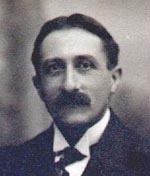
Dr. Wray Wythe Davis was a well-known dentist in Henrico County and his father, Dr. Hugh Wythe Davis was a noted physician that served as a a surgeon in the Confederate hospital service. The father of Dr. Hugh Davis, John Fleming Davis, gave his horse to, according to an eye witness report, one of the last Confederates to cross the Mayo Bridge before Richmond burned.
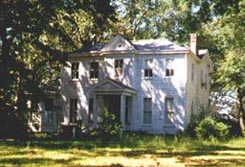
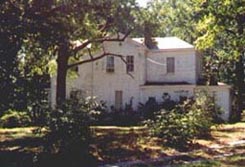
The two top images and the lower left image display the front and side views of the Davis House. The pictures were taken a few years before the house was demolished.
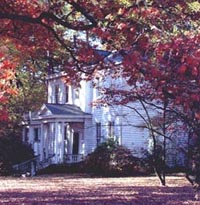
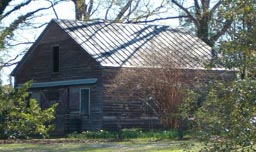
Nestled in the middle of very old and towering trees, one of the outbuildings and the foundation of another remain on the property, where it is said that Dr. Davis generated his own electricity. That was quite a luxury for the period of time in which the house was built considering it would have been in a somewhat rural area.
Below is the obituary of Dr. Hugh Wythe Davis, who died Monday, June 29, 1914. Dr. Hugh Wythe Davis was the father of Dr. Wray Wythe Davis, the owner of the now-demolished Davis House described above.
>Back to Top<
DR. H. W. DAVIS DIES IN HOME HERE
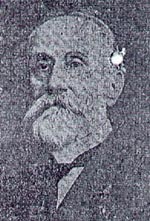
After being in ill health a number of months, Dr. Hugh Wythe Davis about 74 years old; who served with distinction in the Confederate hospital service under Surgeon General Samuel Preston Moore, and who was for more than fifty years, a successful practicing physician, died this morning at 6:15 o'clock in his home, 110 West Grace Street.
The funeral will take place Wednesday morning at 10 o'clock from the home. The service will be conducted by the Rev. Dr. Lloyd T. Wilson, pastor of Grace Street Baptist Church and the burial will be in Hollywood.
Dr. Davis married Miss Mary Elizabeth Apperson of New Kent County, the ceremony being performed by the Rev. Dr. Norwood in Monumental Church Feb. 15, 1865. She died June 4, 1900. He is survived by five daughters - Mrs. H. Seldon Taylor, Jr., Mrs. W. G. Bragg, Mrs. Eva T. Moore, Miss Susie T. Davis, and Miss Edna S. Davis, and his two sons, Dr. Wray Wythe Davis and John A. Davis.
Dr. Davis was a brother of the late Brigadier-General Wirt Davis, who died last February. He leaves two brothers, Dr. E. S. Davis of Cameron, W. VA. and B. T. Davis of Huntington, W. VA.
The career of Dr. Davis was a most honorable one. He was born in Richmond Sept. 30, 1840, being a son of John F. and Mrs. Delight Thomas Davis. He received his education in the schools here, attending Richmond College and the Medical College of Virginia. He graduated in medicine, March 1, 1861.
Not long after Dr. Davis received his diploma as a physician he enlisted for Confederate hospital service, being a close personal friend of Surgeon-General Samuel Preston Moore and also remained his family physician after the war between the state(s). He rendered extensive field service and was on duty for a while in Richmond College while that institution was used as a hospital.
After the war, Dr. Davis was associated in the practice of his profession with his uncle, Dr. Creed Thomas, a schoolmate of Edgar Allen Poe. Dr. Davis was a trustee of Richmond College, the Baptist Home for Aged Women, deacon of First Baptist Church, member of the Medical examining board of the United States recruiting station, and held other positions. He was for a long time a member of the Medical Society of Virginia, in which he took an active interest. He was regarded as a typical Virginia physician of the old school, a man deeply attached to all that pertained to Confederate history, and a loyal citizen of RICHMOND.
The following is an article that appeared in the Richmond Dispatch newspaper on April 6, 1897. It makes note of John F. Davis, father of Dr. Hugh Wythe Davis and grandfather of Dr. Wray Wythe Davis.
>Back to Top<
The Evacuation of Richmond
An Account of it by an Eye-witness
To the Editor of the Dispatch:
During part of the month of February and during March, 1865, the Second Battalion of Virginia Reserves (boys between 16 and 18, and old men between 45 and 50, commanded by the undersigned) were stationed in the city of Richmond on guard duty, having been withdrawn from the lines nearly opposite Fort Harrison, about the 15th of February. On the afternoon of Saturday, the 1st of April, 1865, I went down on a small steamer to "Wilton", the home of my friend, Colonel W. C. Knight, and spent Sunday with him and his family. I expected to return to Richmond early Monday morning. During Sunday all was quiet on the north side of the James river, but away to the south we could hear sounds that indicated a serious engagement. The Colonel and myself walked down nearly opposite Drewry's Bluff, when a steamer - the one I came down on Saturday - passed down loaded, as we thought, with Federal prisoners. As it passed by rapidly we heard from the boat that Richmond was to be evacuated, and that was the last trip the boat would make. As all was so very quiet in our neighborhood, we did not credit this report. About 10 o'clock P.M. Sunday I retired, and before I had fallen asleep the Colonel came to my door, knocked, and informed me that the lines on the north side were being evacuated; that all of his horses and wagons had been just then impressed, and were to be used in moving stores, etc. I was then about nine miles from the city, and my quarters were out in the neighborhood of what was formerly known as Buchanan Spring, so there was nothing for me to do but walk about twelve miles. It was then 11 o'clock at night. I placed in my haversack a small piece of hambone and a loaf of bread, which good Mrs. Knight gave me, little dreaming that I would get nothing more to eat for more than three days.
>Back to Top<
ORDERS TO BURN
Reaching my quarters in the city about 2 o'clock A.M. of the 3rd, my Adjutant Linden Kent, a youth about 18 (who afterwards became a distinguished lawyer in Washington city, and died a few years since), showed me an order from General Ewell, directing all the tobacco warehouses, then full of tobacco, to be burned at a certain signal. He and Capton Herron, of Orange, the ranking officer in my absence (Capton W. T. Early, of Albemarle, and Major James Strange, of Fluvanna, then being absent, sick), had made all the arrangements necessary to carry this order into effect. I directed Captain Herron and Adjutant Kent, so soon as the signal was given, to fire these buildings, then pass over the river on Mayo's bridge, and follow the army. Being dead tired, I threw myself down to rest, fell asleep, and did not waken until the arsenal exploded. This woke me most effectually. I threw my blanket over my shoulder, sword and haversack on one side, and canteen, with a little brandy, on the other. I struck out for Mayo's bridge, some one or two miles distant. The streets were quiet and apparently deserted. When I reached Mayo's bridge the small bridge over the canal connecting the basin with the dock was on fire on one side, a burning canal-boat having drifted up against it.
>Back to Top<
LAST TO CROSS
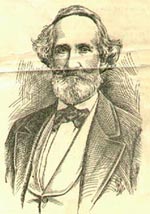
As I was passing over the bridge a few cavalry videttes passed me, I shall ever believe we were the last Confederates who crossed the bridge, for that had also been fired and was now in flames on one side. As I climbed the slope beyond the bridge, the rising sun was just beginning to peep over the eastern hills. I turned and looked back; the city of Richmond was in flames. From all the windows of the Gailego Mills tongues of flame were bursting out; dense clouds of smoke, sparks, and flames were reaching skyward. Were I a painter, even now, after thirty-two years, I could paint the scene. The sight was awfully grand. I felt the end was nigh. After gazing on this sublime spectacle for a time, I trudged on in pursuit of my command. After proceeding about a mile, I met Mr. Davis, father of Dr. H. Wythe Davis* of your city, and brother-in-law of Colonel Knight, who lived nearly opposite Wilton. He was on horseback, and insisted upon my taking his horse. I declined to do so at first, but he remarked that I had better take him, because if I did not the Yankees certainly would. He had dismounted and tendered me the bridle. I took it, mounted; we shook hands and parted - he to return to his home, and I to follow and overtake my command. About 1 o'clock P.M. I overtook them, and we proceeded together with other commands, things being a good deal mixed.
R.T.W. Duke
Late Lieutenant - Colonel Second Battalion, Virginia Reserves
*The other sons of Mr. John F. Davis are: Colonel Wirt Davis, U.S.A.; B.T. Davis, Huntington, W. VA; Dr. John R. Davis, Moundsville, W. VA, and Dr. E. S. Davis, Cameron, W. VA.
- (Mr. Landrum is the grandson of Dr. Wray Wythe Davis)
- (Richmond Dispatch newspaper on April 6, 1897)
>Back to Top<
Forest Lodge
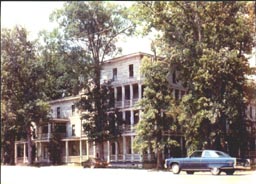
Captain John Cussons, a native Englishman, confederate scout, author, and entrepreneur married Mrs. Benjamin Allen (after whose family Glen Allen was named). He settled here after the Civil War and established a printing company. In 1881, he built a six story fashionable resort hotel with over 100 elaborately decorated rooms known as Forest Lodge adjacent to the railroad tracts. The resort hotel occupied 1000 acres, which also boasted a hunting preserve, lakes, boathouses, gardens, parklands, and an amphitheater. Forest Lodge was never the success it was hoped it would be, and in later years served first as a boarding house, and later as apartments. The parklands reverted to woods. Forest Lodge was demolished in 1989 due to development plans.
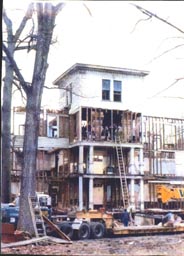
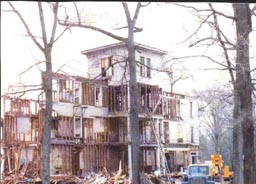
Mr. Wayne Mallory provided pictures and a video of the demolition of historic Forest Lodge for Henrico County archives. He filmed the total demolition of Forest Lodge including the removal of the cupola onto a flat bed truck and the drive down the expanse of Mountain Road. The most moving part of this film is at the end. Mr. Mallory shows in sad silence the pile of rubble that once was this grand hotel, the pride of Glen Allen.
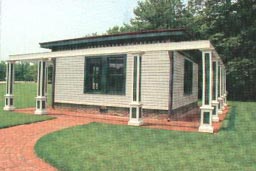
The County of Henrico did not have the demolition of Forest Lodge recorded and were thrilled with this find. They are now using this information to build a miniature replica of Forest Lodge. The County of Henrico preserved this cupola, which now stands on the corner of Mountain Road and Old Washington Highway in the Brookland district.
- (County of Henrico)
- (November 2003 HCHS newsletter)
>Back to Top<
Henley House
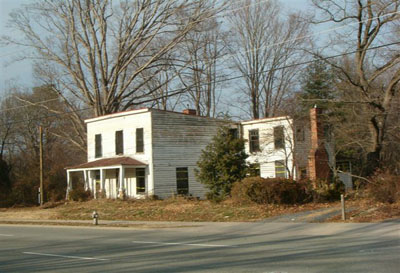
There are not many sites left that reflect the once rural character of Short Pump in western Henrico County. Henley House was an example of rural architecture built in the late 1800s or early 1900s. It was located on West Broad Street just west of Short Pump Town Center, is the second of these buildings. Due to ever expanding development, the house was unfortunately demolished.
According to Trevor Dickerson, who has recorded much of the history of Short Pump:
"The Henley house was a really amazing example of a late 19th century house of its type. It had many huge windows to allow light into the house before electricity came about, and just had a lot of character. The inside was filled with old papers and such, which I sorted through when I went inside, but didn't find anything of historical value other than some 1950's newspapers and other things.
There was a big shed in the back yard with a deep basement, also filled with interesting things. It was very dark and damp down there though and I didn't have a good enough flashlight to really check everything out. I contacted someone with the County about it and they said they were looking into the historic value of the house. In my opinion it was almost beyond repair after someone must have come and heavily damaged the interior and broken through walls, ceilings, etc. But it was still a remarkable structurally-sound house.
I also had remembered talking to the last owner out at Field Day of the Past a couple years ago and I called her up after going through the place to ask her about it. She said the unusual shed out back was used as an antique shop run by her family in the 1970's and that they had gone back through the house and taken a window for each of their children and grandchildren for sentimental value."
The loss of this home is also a loss to our local history.
>Back to Top<
Malvern Hill
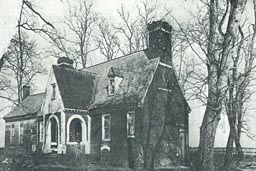
Thomas Cocke (1639-97) built the first house at Malvern Hill. Rebuilt entirely of brick around 1690-1700, the house was sold in the late 18th century to Robert Nelson, brother of Thomas Nelson of Yorktown, signer of the Declaration of Independence. The house burned in 1905.
- (County of Henrico,1995 (HC3))
>Back to Top<
Redwood Reed

According to "Inventory of Early Architecture County of Henrico, Virginia" compiled and edited with introduction by Christopher M. Gregson,
"The farmhouse on the Redwood-Reed Farm is a vernacular dwelling built in the 1880s. It has three-bays, a low-pitched hipped roof and a wraparound porch with heavy Doric columns of 20th-century vintage."
In spite of efforts to save the Redwood Red Farm-House, the Association for the Preservation of Henrico Antiquities is sorry to report that it has been destroyed to make way for new construction starting February, 2005.
- (Inventory of Early Architecture County of Henrico)
>Back to Top<
Short Pump
A number of articles have been written about the area known as Short Pump in Henrico County, mostly as zoning changes have been presented, the result of development plans ever expanding the once primary road leading from Richmond to Charlottesville. Even the name of this road has changed a number of times from its first use during Colonial days as Richmond Turnpike, to Deep Run Turnpike, Route 250, and finally West Broad Street, which is the multi-lane highway that exists today. As we drive westward past the shopping centers, office parks, gasoline stations, and parking lots, pause for a moment to take a trip back to an earlier time when life was simple and the road less traveled. Those who remember, look back with a sense of nostalgia. There is hardly a glimmer of the once rural community left as we recall the history of people and families that lived there whose hard work and sacrifices made possible the progress of today.
Short Pump represents a long and interesting cross-road in American history. Not far away on Three Chopt Road is Deep Run Baptist Church, built in 1749 with wooden pegs and beams that are part of the present structure today. During the Revolutionary War, the church served as a hospital for wounded soldiers and the Marquis de Lafayette reportedly used it as a gathering place (HC 18). Thomas Jefferson, Stonewall Jackson, and Ulric Dahlgren were some of the illustrious visitors to the village in route to their destiny in history.
Land travel in eighteenth century Virginia was usually limited to an average of 30 to 40 miles a day. A 50 mile trip was considered to be long distance. The roads outside of cities often were no more than clearings that meandered to avoid natural obstacles and leading across fordable waterways. The early 1800s saw the beginning of turnpike road development. These roadways were often covered with stone or gravel and tolls were charged according to usage to pay for maintenance.
Below are structures of Short Pump, a couple that have been saved, a few that are in danger of being destroyed, and the majority of which perished long ago.
>Back to Top<
Short Pump Tavern
An 1815 insurance policy, taken out by Robert H. Saunders, shows a tavern located at the confluence of Richmond Turnpike, Three Chopt Road, and Pouncy Tract Road; this tavern appears in the below photo on the left. Those traveling from Charlottesville to Richmond would stop to sleep and to water their horses. Legend has it that this important crossroads was named for the short handled water pump located there. The early part of the 20th century represented the transitional period between animal-drawn and gasoline-fueled vehicles.
The image of a pump amid ruins in the lower left of the photo on the right was found in the Department of Historic Resources file on the Short Pump General Store.
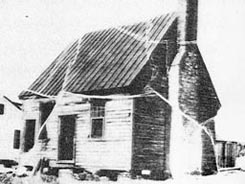
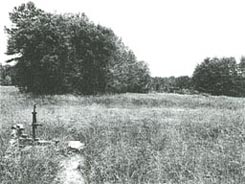
>Back to Top<
Downtown Short Pump General Store (Henley Store)
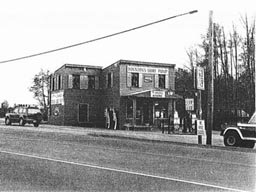
Just east of the Short Pump Tavern at the intersection of Broad Street and Three Chopt Road, Dabney B. Henley constructed and began operating in 1908 what later became known as the Downtown short Pump General Store. The building was described as "having unique stylistic features that expressed the transition from late nineteenth century Victorian, to early twentieth Century Craftsman and Colonial Revival styles." (HABS No. VA-1345).
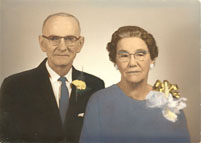
In 1912 Dabney Henley married Inez Wade, whose family lived on Three Chopt Road for several generations. They had two children, Raymond (Tom) Henley and Doris (Henley) Hord. The family resided on the second level above the store. Later, both of their children would build homes and live near-by.
In general, rural stores were centrally located at the junction of two roads or in small villages, as was the case at Short Pump. Often the only retail establishment serving a large area, the general store stocked a wide variety of items to serve the needs of the community. Baloney sausage, salt herring in a barrel, lard, and chicken feed are some of the items it is said the Henleys sold in their store. In addition to providing necessary supplies, the store was a social center, where residents in the community would hear and dicuss political and social issues. One local resident said he stopped by the store every day on the way home from work just to keep up with the news in the community.
After Dabney Henley retired, the building was used as an antique store for a number of years. Dabney Henley died in 1969 and after the death of Mrs. Henley in 1979, the property was eventually owned by Richard and Susan Friedman. They ran Downtown Short Pump The General Store until the property was sold and later demolished in 1996 to accommodate the widening of Broad Street. Plans to move the building failed because of structural problems. Several local artists have preserved the image of the Short Pump Grocery Store in their work. Such rurual commercial buildings, once prevalent throughout Henrico County, are now threatened with extinction.
>Back to Top<
Short Pump School
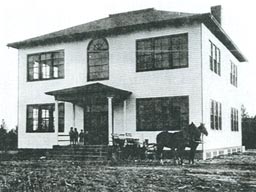
The entire community celebrated the dedication of a new school in Short Pump on December 6, 1911. The new school consolidated several one-room school houses in the area to accommodate grades 1-9. Mattie W. Mills served as principal with 98 pupils enrolled. Transportation to school became a necessity for pupils living in the outlying areas. A covered wagon with benches on each side and pulled by two mules was used. Clifton Henley was the first driver, followed by Grayson Nuckols and Henry Wade.
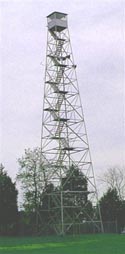
The frame, two story building was replaced in 1926 with a brick one-story building with the modern convenience of indoor plumbing. After several renovations and additions this building remains at the core of the present building. The school continues to serve a still thriving community.
>Back to Top<
Short Pump Fire Tower
Also serving the Short Pump area was a fire tower similar to the one pictured that was preserved in Goochland County.
Mason Wade was at one time the attendant of the tower in Short Pump and twice a day he would climb to the top for observation, the only method of that time for detecting forest fires. As these towers have outlived their usefulness, they too have become obsolete and have disappeared from the landscape.
>Back to Top<
Sinclair Gas Station and Short Pump Transmission Shop

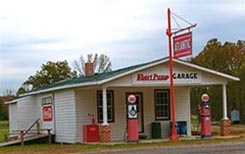
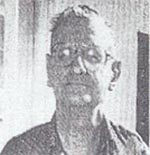
Built in the 1930's, the building in the left picture was originally a Sinclair Gas Station when gas was 5 gallons for a dollar. It later became a Convenience Store.
Pictured on the right, the Short Pump Transmission Shop was purchased by Berger Nuckols in 1945. It was located near where the Wal Mart is today.
Luckily, these two buildings were saved. They were moved from the Short Pump area in 1996 and restored. They are now part of the "Field Days of the Past" exhibit in Goochland County.
>Back to Top<
Brock House
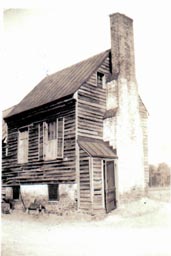
History provided by Jean Harper, granddaughter of Royall Ashby Brock
The Brock House was on Broad Street Road between Pemberton and Cox Roads. It is a long gone now, into the jaws of progress, shopping malls and apartments. It was the home of William Henry Brock and Columbia Marshall Brock. They had six children, two daughters: Addie Brock Butler and Beulah Brock Lawrence; and four sons: Royall, Wellie, Leslie and Linwood. Mr. Brock died fairly young and Mrs. Brock married again to a Mr. Brown, but it was not a long marriage and there were no children by thqt marriage. Mrs. Brock continued to live many years in her home even after she was bedridden. She was looked after by her brother, Bill Marshall, and his wife, who lived with her and by her son, Leslie, and his family who lived just east of her.

It is not known how old the house was, but these pictures are believed to have been taken sometime in the late 1930's or early 1940's. The house had two very large rooms across a center hall that ran from back door to front. The Marshalls lived in the room on the western end of the house, which had a small kitchen attached. Mrs. Brock lived in the other room on the eastern end of the house, which had a staircase leading down to an English basement. It was said there was once a tavern keep in the basement. The house also had attic bedrooms that were unused and unusable toward the last years of the house.
Date of demolition unknown.
>Back to Top<
Bowles Farm
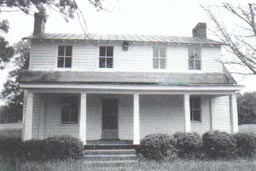
Joe and Luttie Bowles had owned this farmhouse, once located on Three Chopt Road, since the early part of the 20th century. Built ca. 1790-1810, the original house was one-story and heated by corner fireplaces feeding into a broad exterior Flemish bond chimney with tiled weatherings. The original structure was extended to the west in the mid-19th century by a one-room addition with an exterior end chimney of random American bond. (Inventory of Early Architecture County of Henrico, Virginia). This property was demolished in 2001.
>Back to Top<
Erin Shades
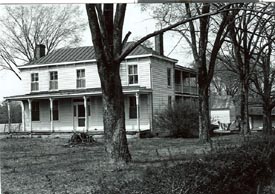
This was the home of Courtland J. Nuckols and Hariett A Nuckols.
It was previously located at Broad and Cox Road, what is now the present site of Innsbrook Office Park.
>Back to Top<
Nuckols House:
See Nuckols House.
>Back to Top<
Springfield Baptist Church:
See Springfield Baptist Church.
>Back to Top<
Other Former Structures of Short Pump:
The Nunally Thrift Farm was located at the present location of Sams Discount Club. This dairy farm included one mile of frontage on Broad Sreet. At one time dairy farming was a thriving industry in Henrico County, but today there are no dairy farms still in existence in the County.
Larid's Nursery, formerly on Springfield Road, could also be seen from Broad Street.
In later years, Par 3, a nine hole golf course, was located just west of Gaskins Road that had lighting at night. Further west was Tilly's Kitchen, a dance hall night club, where entertainment could be had and folks could "brown-bag" their liquor before the law changed to allow liquor to be sold by the drink in restaurants.
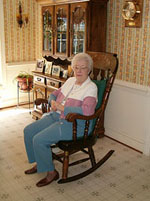
The Short Pump area continues to grow. The latest expansion calls for the development of one of the last tracts of land left, the Liesfeld Farm.
It will be mixed use of office, retail and residential space and will be called Englewood. This development will erase the last remaining homes of a family that has lived in the Short Pump area for several generations. Ruth Henley, widow of Raymond (Tom) Henley, and her daughter, who lives next door, will lose their homes to this development plan.
Once again the area where Mrs. Henley's father-in-law and mother-in-law, Dabney and Inez Henley, ran the Short Pump General Store will be altered forever. It is quite possible that for the first time what once was Three Chopt Road will not intersect with West Broad Street.
Seasons change and times moves on.
After the section of Interstate 64 that bypassed the Short Pump area opened from 1966 to 1968, the sleepy little village was all but forgotten until the vision that became Innsbrook exploded the area into the commercial center it is today.
Short Pump was once just a place on the map along a road to Charlottesville. It was never an incorporated town; never had a village square; it never had an official Mayor. To the people who lived there it was a place called home and their stories are history now. The story of Short Pump goes on. It's face has changed but it continues to survive and it remains to this day a place on the map along a road to Charlottesville.
>Back to Top<
- (Inventory of Early Architecture County of Henrico)
- (Jean Harper, granddaughter of Royall Ashby Brock)
- (HC 18)
- (HABS No. VA-1345)
>Back to Top<
Lost Architecture Sites: All Sites
Brookfield Plantation | Davis House | Forest Lodge | Henley House | Malvern Hill |
Redwood Reed| Short Pump
Home | Henrico | Maps | Genealogy | News | Membership | Shopping | HCHS
|











